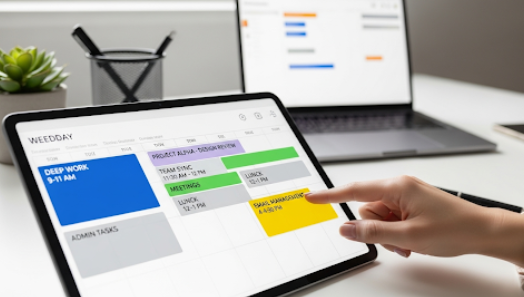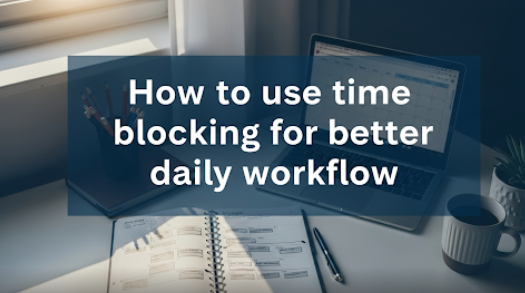A Guide to Mastering Productivity — With Time Blocking For A More Efficient Daily Workflow
DO YOU FEEL SCATTERED EVERYWHERE THROUGHOUT YOUR DAY GOING FROM TASK TO TASK NEVER REALLY TAKING CARE OF ANYTHING FULLY? Are you the one who keeps getting distracted thinking where does all the time go? You’re not alone. Managing your daily schedule is something so many of us continue to have difficulty with. The good news is there’s a solution so simple yet so powerful: time blocking.
Time blocking is a time-management productivity technique wherein you divide your day into blocks of specific times for different tasks or activities. You replace your simple to-do list with time-block scheduling. It turns your massive disastrous day into an organized, methodical schedule with efficiency — that will get you results.
Here is a complete guide you need to read on time blocking from basic to advanced strategies. You may be a student, professional, entrepreneur or busy parent yourself and would most probably benefit from this system to dramatically change how you get through the day accomplishing so much more with less effort!
Why Time Blocking Works
This is due to the fact time blocking solves poor time management at its roots. If you do not have a plan for your day, your brain is then making decisions directly with respect to what you will do next. This decision fatigue depletes your willpower and results in procrastination.
When you assign your tasks to specific time slots, you take out the guesswork. Your mind automatically chooses where to focus at any point. It relieves your brain of a ton of noise, but also lets you focus more and get done faster.
In fact, research has shown that using time blocking makes you over 40% more likely to achieve your goals than using traditional to-do lists. It also forces you to be more honest with yourself about how long things actually take, which will enable better planning and far less stress.
The Physics of Time Management Success
Your brain functions more effectively when there are clear rules and guidelines. By claiming specific chunks of time to complete tasks, first you mentally carve out the space in your schedule for those things. This is how your brain wants to receive and retain information.
Because you are jumping from one type of task to another, each time the transition requires your brain to refocus. In more concrete terms, the cost of this mental switching can reduce your productivity up to 25%. Time blocking groups activities of the same nature and designates set times for focus periods to limit these transitions.
First Time Blocking Setup Guide
Choose Your Tools
Before you deep dive into time blocking, get the right tool in place. You can use:
Digital calendars:
- Google Calendar (accessible from anywhere)
- Microsoft Outlook (Good for integration with work)
- Apple Calendar (for Mac & iPhone Users)
- Notion, or ClickUp (for more advanced project management)
Physical planners:
- Daily desk calendars
- Weekly planner notebooks
- Wall calendars for visual tracking
Hybrid approaches:
- Digital calendar for planning, paper notes to go over
- Synced calendar apps across all devices
Choose one platform, and stick with it. The time block method is not meant to overwhelm or confuse with multiple systems; it is one main system working in tandem with others.
Map Out Your Current Schedule
A week before you start just keep tracking how you spend your time currently. Keep track of everything you do every 15-30 minutes. This baseline helps you identify:
- The time wasters you now know exist
- Tasks that take longer than expected
- Your rhythms of energy throughout the day
- Regular time slots for regular activities
Real Time Management Techniques You Should Be Mastering
The Color Coding System
Give different colors to activities in your schedule:
| Activity Type | Suggested Color | Notes |
|---|---|---|
| Work tasks | Blue | Meetings, reports, emails |
| Personal care | Green | Exercise, meals, sleep |
| Learning | Yellow | Reading, courses, skill development |
| Family time | Orange | Kids’ activities/quality time |
| Household | Purple | Cleaning, errands, maintenance |
| Recreation | Red | Hobbies, entertainment, relaxation |
It’s a visual representation of what your ideal schedule would look like that helps you see if, at-a-glance, you are balanced and prioritizing all areas of life, rather than just a few.
The Three-Block Method
Divide your day into three big buckets:
Morning Block (6 AM — 12 PM): Prioritize High-Energy, Significant Tasks This is the time to hunker down and focus when your creative faculties are at their freshest. This might include:
- Creative work
- Problem-solving
- Important meetings
- Exercise
Afternoon Block (12 PM — 6 PM): Get the routine stuff and collaborative work done When you are awake but not completely energized:
- Administrative tasks
- Team collaboration
- Customer communications
- Planning for tomorrow
Evening Block (6 PM — 10 PM): Take it easy with fewer tasks and me-time:
- Family dinner
- Relaxation activities
- Light reading
- Preparation for the next day
Buffer Time: Your Secret Weapon
The most common mistake beginners make is they simply pack things too tightly, scheduling task after task with no room for a break. ALWAYS include buffer time for activities:
- 5-10 minutes between short tasks
- 15-20 minutes between meetings
- 30 minutes when moving from one type of work to another
Free time is what you have when your things go according to schedule, buffer time on the other hand takes into consideration that some tasks may take longer than it seems, there may be an unexpected interruption or simply we need a mental transition from one activity to another.

Advanced Time Blocking Techniques
Theme Days for Maximum Focus
Instead of slotting in scattered types of work throughout the week, theme certain days to be entirely focused on one thing:
Monday – Planning and Strategy
- Weekly planning session
- Goal review and adjustment
- Project prioritization
- Calendar organization
Tuesday – Deep Work
- Important projects
- Creative tasks
- Problem-solving
- Research and analysis
Wednesday – Communication
- Meetings and calls
- Email responses
- Team collaboration
- Client interactions
Thursday – Administrative Tasks
- Paperwork and filing
- Financial tasks
- System updates
- Process improvements
Friday – Review and Preparation
- Weekly review
- Next week preparation
- Loose end completion
- Celebration of wins
Energy-Based Scheduling
Match the tasks you complete with your energy levels during the day:
High-Energy Tasks (Peak Performance Times):
- Complex problem-solving
- Creative work
- Important decisions
- Learning new skills
Medium-Energy Tasks (Steady Performance Times):
- Routine work
- Team meetings
- Email management
- Planning activities
Low-Energy Tasks (Recovery Times):
- Administrative work
- Organizing files
- Light reading
- Simple, repetitive tasks
Observe your energy rhythms for two weeks noting when you feel sharp and when you feel drowsy. Typically, people peak in energy during the morning hours and just after lunch with drains in mid-afternoon and evening.
The Pomodoro Integration Method
Use time blocking PLUS the Pomodoro Technique:
- Carve out 120-minute blocks of focus time
- Work focused within blocks of 25 minutes
- Take 5-minute breaks between sessions
- Take 15–30 minutes longer breaks between blocks
You get the time blocking structure combined with Pomodoro intensity.
How to Create A Daily Time Block Schedule
Morning Routine Block (6:00 AM — 8:00 AM)
6:00-6:30 AM: Wake-up routine
- Quick shower or face wash
- Light stretching or meditation
- Healthy breakfast preparation
6:30-7:00 AM: Personal development
- Reading (books, articles, news)
- Skill learning (language, online course)
- Journaling or goal visualization
7:00-8:00 AM: Physical activity
- Gym workout
- Home exercise routine
- Walk or bike ride
- Yoga or stretching
Work Blocks (8:00 AM — 5:00 PM)
8:00-8:30 AM: Day preparation
- Review daily schedule
- Check priority tasks
- Set daily intentions
- Quick look at emails (do not yet respond to any)
8:30 — 10:30 AM: Deep work block #1
- Most important project
- Complex problem-solving
- Creative tasks
- Strategic planning
10:30-10:45 AM: Break and reset
- Physical movement
- Hydration
- Brief mental break
- Prepare for next block
10:45 AM-12:00 PM: Communication block
- Email responses
- Phone calls
- Team check-ins
- Client communications
12:00-1:00 PM: Lunch and recharge
- Nutritious meal
- Brief walk outside
- Mental reset activity
- Social interaction
1:00-3:00 PM: Deep Work Block #2
- Secondary important project
- Detailed analysis
- Research activities
- Content creation
3:00-3:15 PM: Afternoon break
- Light snack
- Physical movement
- Energy boost activity
- Mental transition
3:15-4:30 PM: Administrative block
- Routine tasks
- Filing and organization
- System updates
- Process improvements
4:30-5:00 PM: Day wrap-up
- Task completion review
- Tomorrow’s preparation
- Calendar updates
- Workspace organization
Evening Block (5:00 PM — 10:00 PM)
5:00-7:00 PM: Personal/Family Time
- Quality time with loved ones
- Household responsibilities
- Personal errands
- Dinner preparation and eating
7:00-8:30 PM: Personal interests
- Hobbies and recreation
- Entertainment (TV, movies, games)
- Social activities
- Creative pursuits
8:30-9:30 PM: Evening preparation
- Next day planning
- Relaxation activities
- Light reading
- Gratitude practice
9:30-10:00 PM: Sleep preparation
- Personal hygiene
- Technology shutdown
- Bedroom preparation
- Meditation or quiet time
Handling Common Time Blocking Challenges
Dealing with Interruptions
Interruptions are many and they are going to come, but you can make sure that they will not affect your workflow heavily.
Create interruption protocols:
- Establish “Open Door” availability at scheduled times
- Use signal tools (headphones, door signs, calendar blocks)
- Have quick response templates ready
Build interruption buffers:
- Extra time for priority blocks (20%)
- Flex time to save your day when an unexpected problem crops up
- Have alternative backup tasks to fill shortened blocks
- Plan how to return your focus quickly after interruption
Perfectionism Paralysis
The biggest issue that many people face is making a time blocking system perfect. Remember:
- Implement a basic system and scale up
- A slightly imperfect system you actually use is more useful than a theoretically flawless system that you abandon
- Adapt the blocking to actual practice, not hypothetical targets
- Focus on progress, not perfection
Overcommitment Issues
With time blocking you get a true scale of how much you can reasonably get done. This makes it easier to understand how long you will need:
- You cannot do the work of 10 hours in 8 hours
- Time to travel from one activity to another
- You need breaks to perform well
- Some problems always take longer than the estimate
Use your self-awareness to commit and expect more realistically from others.
Time Blocking for Different Lifestyles
Students and Academic Success
Study blocks:
- 1-2 hours for harder subjects
- 1 hour sessions for easier subjects
- 30 minutes to review before each test
- Regular breaks to maintain concentration
Assignment management:
- Block out times for big projects over the course of a few weeks
- Set aside time for research, separate from writing time
- Incorporate time to revise and edit your work
- Schedule study group sessions
Entrepreneurs and Business Owners
Revenue-generating activities:
- Client work blocks (major time commitment)
- Sales and marketing activities
- Business development meetings
- Networking events
Business management:
- Administrative tasks
- Financial management
- Team management and training
- Strategic planning sessions
Working Parents
Family integration:
- Morning routine with kids
- After-school activity coordination
- Evening family time
- Weekend family activities
Personal balance:
- Early morning personal time
- Lunch break self-care
- Evening wind-down routine
- Weekend personal projects
Time Blocking Apps & Tools to Take Your Game to the Next Level
Calendar Applications
Google Calendar Features:
- Multiple calendar overlay
- Color coding system
- Mobile notifications
- Easy sharing with others
- Integration with other Google tools
Microsoft Outlook Advantages:
- Email integration
- Team scheduling features
- Task management
- Professional meeting tools
Specialized Time Blocking Apps
Clockify:
- Time tracking integration
- Project-based blocking
- Team collaboration features
- Detailed reporting
RescueTime:
- Automatic time tracking
- Website and app monitoring
- Productivity scoring
- Distraction alerts
Forest App:
- Gamified focus sessions
- Phone usage reduction
- Visual progress tracking
- Achievement system
Physical Planning Tools
Bullet Journals:
- Completely customizable
- Combines planning with reflection
- No technology dependence
- Creative expression outlet
Desk Calendars:
- Always visible schedule
- Quick reference access
- Easy modification
- No battery or internet required
Measuring Your Time Blocking Success
Key Performance Indicators
Track these metrics to monitor your improvement:
Completion Rate:
- Percentage of planned tasks completed
- Quality of completed work
- Time accuracy (planned vs. actual)
- Consistency over time
Stress and Satisfaction Levels:
- Daily stress ratings (1-10 scale)
- End-of-day satisfaction scores
- Energy levels throughout the day
- Overall life balance assessment
Productivity Metrics:
- Important tasks completed per day
- Deep work hours achieved
- Interruption frequency
- Goal achievement progress
Weekly Review Process
Spend 30 minutes a week reviewing your time blocking effectiveness:
What worked well this week?
- What were your best performing time blocks?
- Where did you feel most in the zone?
- What scheduling decisions led to success?
What challenges did you face?
- What blocks were you consistently running long in?
- What unexpected interruptions occurred?
- Which parts felt rushed or frustrating?
What adjustments will you make?
- Ways you can improve your time estimates
- How much buffer time do you need to build in?
- Which activities need different time slots?
What wins can you celebrate?
- Goals achieved through time management
- Improvements in work-life balance
- Reduced stress or increased satisfaction
Turning Time Blocking Into a Permanent Habit
The 21-Day Implementation Plan
Week 1: Basic Structure
- Create your time blocking system of choice
- Create a simple daily template
- Only concentrate on major time blocks
- Keep track of what performs best and least
Week 2: Refinement
- Add more detailed time blocks
- Implement color coding
- Introduce buffer times
- Start energy-based scheduling
Week 3: Optimization
- Fine-tune time estimates
- Add advanced techniques
- Create backup plans for interruptions
- Establish review routines
Week 4 and Beyond: Mastery
- Maintain consistent daily practice
- Regular weekly reviews and adjustments
- Experiment with new techniques
- Share knowledge with others
Building Long-Term Success
Start Small: Do not jump right into time blocking every single hour of the day. Create a few large blocks, then fill in the detail as things develop over time.
Stay Flexible: Life will go on, so you need to be flexible within structure. Time blocking provides the structure. Realize that you need to adapt but keep the essence of your whole system.
Regular Updates: As your needs change over time, getting these system updates is something all of us have to deal with.
Get Support: Get an accountability buddy to share how you plan to block your time and ask someone to support you.
Celebrate Progress: Acknowledge your time blocking victories!
Conclusion
Time blocking is not just another productivity trend, it’s a working system that can change your whole daily behavior. Remember, it is best to start with the bare minimum then be consistent and refine your approach step-by-step based on actual experience.
This is not about putting something together so strict that life becomes nothing more than a programmed response day to day. When you know exactly what you should be doing at any moment, you can give 100% of yourself to that task without worrying about all the things on your plate.
Start with just three time blocks tomorrow — morning routine, work focus time, evening wind-down. Spend one week on these blocks, and then slowly add more complexity to your system.
Time blocking will help you get more done on what is important to you and reduce your daily stress. The time you spend establishing and maintaining this system will be paid for with improved productivity and reduced feelings of overwhelm — as well as satisfaction when looking back over how you’ve spent your days.
Start small, stay consistent and see how time-blocking can change not only your workday, but also even the busiest days as well! Control your time today so you can let your future self thank you later.




